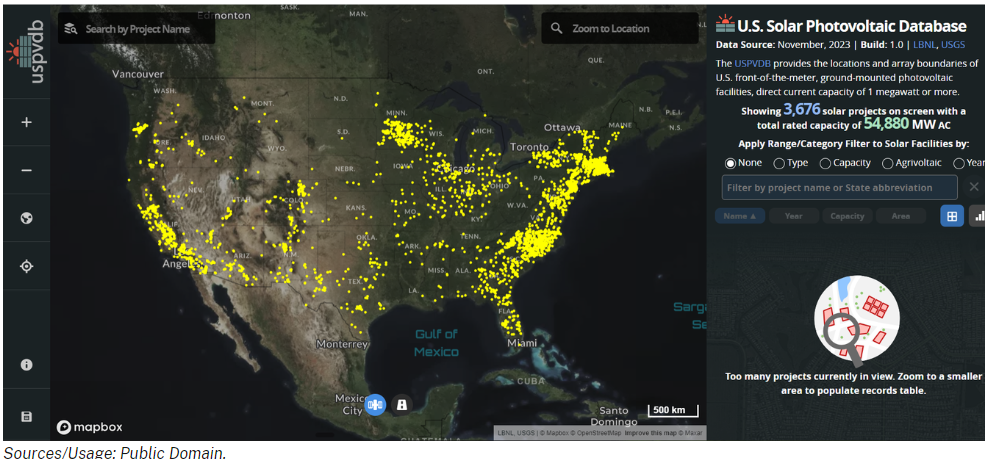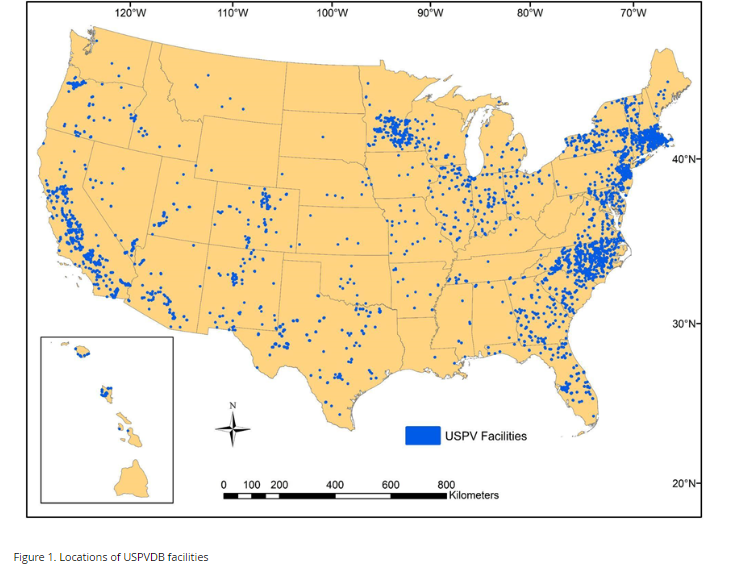Highlights :
- DOE released an online dataset of solar facilities greater than 1 MWdc, which are operational across 47 states.
- Berkeley Lab and USGS (U.S. Geological Survey) released this report in collaboration with the U.S. Department of Energy’s (DOE).
 US Announces $104 Million Investment Plan For New Net-Zero Facilities
US Announces $104 Million Investment Plan For New Net-Zero Facilities Berkeley Lab and USGS (U.S. Geological Survey) in collaboration with the U.S. Department of Energy’s (DOE) produced a publicly available database. The detailed Large-Scale Solar Photovoltaic Database (USPVDB) aims to map ground-mounted photovoltaic (PV) facilities with capacity of 1 megawatt.
This come alongside US’s DOE (Department of Energy) data, that released an online dataset of solar facilities greater than 1 MWdc. These facilities are operational across 47 States which reportedly countians data about the new, large-scale solar and all ground-mounted commercial U.S. solar photovoltaic facilities. They reportedly countian capacities of one megawatt or greater. EIA classifies all solar facilities with capacities of one megawatt or greater as large-scale and those with capacities of less than one megawatt as small-scale.
The database provides the locations and array boundaries of the U.S. ground-mounted photovoltaic (PV) facilities with capacity of 1 megawatt or more. It included corresponding PV facility information, including panel type, site type, and initial year of operation. It shared a detailed and comprehensive dataset of ground-mounted large-scale solar (LSS) photovoltaic energy facility locations and their attributes in the United States.
Over the past decade, LSS development has reportedly increased substantially in terms of both electricity generation capacity and the number of new facilities coming online each year. The USPVDB provides the means to analyze the historical trends in LSS. It also more accurately assessed the potential costs and benefits of future development, while also provided an unprecedented easy access to anyone curious about LSS substantial recent build-out.
An article published in Nature Scientific Data described the USPVDB and provided high quality data on the location and attributes for nearly LSS facilities across the United States. The dataset comprises 3,699 LSS ground-mounted facilities with capacities greater than 1 MWdc in operation across 47 states and Washington, D.C. through the end of 2021
The database contained both geospatial polygons with installed equipment such as panels and inverters. The polygons were reportedly hand-drawn using high resolution aerial imagery. This the report indicated to be a significant improvement over other datasets, including that of the Energy Information Agency (EIA), that only contain coordinates of the central point of a large-scale solar facility, which are not independently verified for accuracy.
The USPVDB database includes detailed facility attributes, including size of the array area, panel technology type, axis type, year of installation, and rated capacity to produce electricity. Further, the USPVDB brought a variety of attributes together, such as, if the location was presently or previously environmentally contaminated and if the facility has agrivoltaic features.

US’s DOE Released Data of Ground-Mounted Solar Greater Than 1 MWdc
The team produced data through merged attributes from the Environmental Protection Agency’s RE-Powering data and the National Renewable Energy Laboratory’s InSPIRE agrivoltaics data. This allowed the USPVDB to, respectively, provide depictions of facility site types, such as greenfield or previous, current, or suspected contamination, as well as identify agrivoltaic facilities where agricultural or environmental services are provided between panel groups or surrounding arrays.
Earlier they had released map in which they claim to have, “Nearly 4,000 solar systems are mapped in this database, providing a crucial new asset for researchers, energy planners, government, and the solar industry,” said Jeff Marootian, principal deputy assistant secretary for energy efficiency and renewable energy. “The abundance of detailed information in this database will help us improve the responsible siting of large-scale solar energy projects across the country to benefit communities and meet our climate goals.”

They had earlier established that, the ground-mounted solar could require 5.7 million acres by 2035 and as much as 10 million acres in 2050 in order to achieve the Administration’s decarbonization goals. The USPVDB is part of DOE’s ongoing research to reduce the cost and understand the impacts of siting solar and to develop strategies for maximizing benefits from large-scale solar facilities to host communities. The report adds that researchers, decision-makers, and other stakeholders can use the data to analyze the role of solar energy in decarbonizing the U.S. electric grid. It can help to improve studies on the interactions between PV facilities and the natural environment, plan investments in PV infrastructure, and more. The dataset, which will be updated annually, will be downloadable in multiple formats and accessible via an online map viewer.
“With the release of the database, data that were previously scattered across several datasets—and in some cases unavailable to the public—have been released to the public in a single package via the new viewer that we’re launching,” said USGS scientist Jay Diffendorfer, who co-led the effort. “With the release of this public version, we hope researchers and other interested parties around the world will use the data to further their efforts.”





























